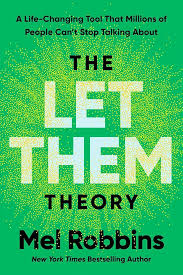
If you’re an avid podcast listener like I am, you’ve probably come across the “Let Them” theory—whether it’s from The Skinny Confidential or Life with Marianna. I’ve found myself naturally incorporating this idea into my everyday conversations, and I’ve realized how much it has truly transformed the way I approach life.
Today, I want to dive deeper into this concept and share how embracing it can make a real difference in your life too.
Let’s get into it!
To start “Let Them” and “Let Me” are two ideas Mel Robbins talks about to help us stop worrying about other people’s opinions.
- “Let Them” means letting others have their own thoughts, opinions, or judgments about you, without feeling like you have to change or please them. You can’t control what others think, so stop stressing about it.
- “Let Me” is about giving yourself permission to do what you want and follow your own path, regardless of what others might think. It’s about letting yourself be who you are, without guilt or fear of judgment.
Together, these ideas remind us to focus more on being true to ourselves and less on trying to control or impress others.
Integrating the Let Them, Let Me theory into everyday life involves practicing a mindset of balance, acceptance, and self-awareness. At its core, the theory encourages individuals to let others be themselves without judgment or attempts to change them, while also allowing themselves the freedom to express their true desires and needs.
When it comes to friendships, the Let Them, Let Me approach is all about allowing space for both you and your friends to be yourselves—without judgment or pressure.
In practice, this means giving your friends the space they need to be who they are, even if it’s not exactly how you would handle things. For example, if a friend is going through something difficult, instead of jumping in with advice or trying to “fix” the situation right away, try just listening.
Sometimes, all someone really needs is to feel heard and understood. It’s about being present, not always proactive with solutions. In these moments, respecting their way of doing things—even if it’s different from yours—shows them you trust their judgment and gives them the freedom to navigate life in their own way. It’s about offering support without controlling the narrative, letting them choose their path, and showing up for them without imposing your own expectations.
On the flip side, Let Me is about respecting your own boundaries and needs within the friendship. Just as you give your friends the freedom to do things their way, it’s important to do the same for yourself. Don’t feel guilty for setting boundaries or saying “no” when something doesn’t align with your needs. It’s okay to put yourself first and to make decisions that are true to your own values and desires. By honouring your own space and wishes, you not only protect your own well-being but also create a more authentic and fulfilling connection with your friends. You teach them that it’s okay to prioritize their own needs, too, without worrying about judgment or obligation.
Here is a scenario to better understand it:
Scenario: You (Friend 1) found out that your friend (Friend 2) didn’t invite you to their birthday party. Naturally, you’re feeling hurt or confused.
Step 1: Acknowledge Your Emotions
(First, recognize your feelings and give yourself space to feel them. Don’t suppress your emotions, but also don’t let them control your reactions.)
Friend 1 (You):
“Okay, I feel hurt. I wasn’t invited to their birthday party, and I feel left out. It stings.”
Friend 2 (Me, Your Thought Process):
“It’s okay to feel hurt; your feelings are valid. But let’s pause here. Let’s take a moment to think. This isn’t necessarily about you or anything wrong with you. It’s about them and their choices.”
Step 2: Apply “Let Them”
(Next, remember the first part of Mel Robbins’ theory—Let Them. This means recognizing that other people have their own reasons for doing what they do, and those reasons are about them, not you.)
Friend 1 (You):
“But why would they not invite me? I thought we were close.”
Friend 2 (Me, Your Thought Process):
“Okay, so here’s the thing: Their reasons could have nothing to do with me personally. Maybe they had a small guest list and had to make tough choices. Or maybe they were just focused on certain people or circumstances. Maybe they felt awkward about inviting me for some reason, or maybe there’s something going on in their life that I don’t know about. People have a lot of different reasons for their decisions—none of them necessarily reflect how they feel about me.”
Step 3: Shift from “Let Them” to “Let Me”
(The second part of the theory—Let Me—is about focusing on how you can manage your own reaction and behaviour. It’s about taking responsibility for your feelings and responses, without letting other people’s actions determine your worth or happiness.)
Friend 1 (You):
“But I feel so left out. Why does this always happen to me?”
Friend 2 (Me, Your Thought Process):
“Okay, hold up. Let’s take a step back and reframe this. Yes, it’s disappointing, but it’s important not to jump to conclusions. I can’t control their actions, but I can control how I handle this. I don’t have to let this define my friendship or my sense of self-worth. If they didn’t invite me, maybe it’s because their priorities are elsewhere right now—or maybe it’s a mistake. I don’t need to make it mean that I’m unimportant. I can choose to respond in a way that preserves my peace, whether that means addressing it directly with them or simply letting it go.”
Step 4: Reframe the Situation
(Here, you take control of your mindset, recognizing that the situation is not as personal as it feels in the moment.)
Friend 1 (You):
“I guess I don’t have all the information. I should be open to hearing their side. Maybe it wasn’t about me at all.”
Friend 2 (Me, Your Thought Process):
“Exactly. Maybe they just weren’t thinking about how not inviting me might affect me. People are busy, sometimes they don’t see things from other perspectives. That doesn’t mean they’re a bad friend—it’s just human nature. And remember, my worth isn’t defined by whether I was invited or not. I have the choice to stay in the present moment and choose not to let this one situation define how I feel about myself or our friendship.”
Step 5: Decide How You Want to Move Forward
(Once you’ve processed your feelings and given yourself space to think, you can now decide how to respond and move forward.)
Friend 1 (You):
“I’m still a bit hurt, but I don’t want to carry this negativity. Do I want to bring it up with them, or do I let it go?”
Friend 2 (Me, Your Thought Process):
“If I feel comfortable doing so, I could just ask them in a calm way if there’s a reason I wasn’t invited. But if I don’t feel like it’s worth bringing up, then I can just focus on the positive parts of our friendship and not let this one moment determine everything. This doesn’t define our relationship, and it doesn’t define me. I’m still valuable, and I still have great friendships.”
Step 6: Take Ownership of Your Response
(Finally, acknowledge that you are responsible for how you handle this, and you can move forward without letting this situation drag you down.)
Friend 1 (You):
“Okay, I’ve processed this. It’s okay to be disappointed, but I also realize I don’t need to let it affect my whole perspective. I can keep my self-respect intact and decide how I want to engage moving forward. If it feels like a pattern, I might address it—otherwise, I’ll move on.”
Friend 2 (Me, Your Thought Process):
“Exactly. You’ve got this. Keep focusing on the things that matter to you, and remember—you control how you respond, not what others do.”
By following this process, you use the “Let Them and Let Me” framework to separate your emotional response from the actions of others, and empower yourself to choose how you respond to situations, rather than reacting impulsively.
The “Let Them” theory isn’t just a catchy phrase—it’s a mindset that can reshape how we navigate challenges, relationships, and personal growth. By embracing this concept, we free ourselves from unnecessary stress and expectations, allowing us to live more authentically and confidently. Whether it’s letting go of others’ opinions or choosing not to take on burdens that aren’t ours to carry, adopting this mindset opens up space for greater peace and fulfillment. I hope this idea resonates with you as much as it has with me, and I encourage you to give it a try in your own life. Let them—whatever or whoever they are—be, and watch how it shifts your perspective.
